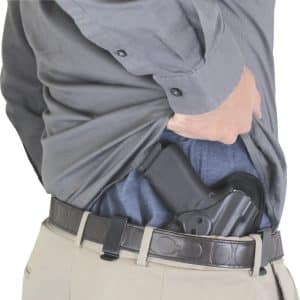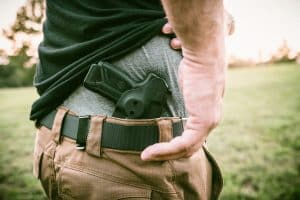
The Ultimate Guide to Choosing a Holster for Effective Concealment
Concealed carry is a responsibility that comes with the need for discretion and readiness. Selecting the right holster is crucial to ensure your firearm is both effectively concealed and readily accessible. This comprehensive guide will walk you through the various aspects to consider when choosing a holster that best suits your concealed carry needs.
Understanding Holster Types
The type of holster you choose plays a pivotal role in how well you can conceal your firearm:
- Inside-the-Waistband (IWB) Holsters: These are preferred for optimal concealment because they sit inside your pants, which helps minimize the weapon’s profile against your body. IWB holsters are ideal for various carry positions around the waist, including behind the hip (4-5 o’clock) and the appendix position (1-2 o’clock).
- Outside-the-Waistband (OWB) Holsters: OWB holsters are a bit bulkier since they sit on the outside of your pants but can still be effectively concealed under a longer jacket or shirt. They are generally considered more comfortable, especially for extended periods.
- Universal Comfort Cling: This type of holster offers a unique blend of comfort and concealability. The Comfort Cling uses friction to stay in place instead of traditional clips, which reduces bulk and allows for versatile placement along the waist.
Importance of Profile and Design
A holster with a low profile tends to be better at concealing a firearm. Look for designs that are streamlined and minimize excess material, which can reduce printing—the visible outline of the gun under your clothes.

Clothing Considerations
Your wardrobe plays a significant role in how effectively you can conceal a firearm:
- Fit of Clothing: Looser clothing can more easily disguise the bulk of a gun and holster. Tight-fitting garments might reveal the contours of your holster and firearm.
- Layering: Wearing multiple layers can help obscure the shape of your firearm. A jacket or a sweater over a shirt can effectively hide even larger handguns carried in IWB or OWB holsters.
Optimal Carry Position
The position where you carry your firearm on your body significantly affects concealment:
- Appendix Carry: Allows for easy access and can be effectively concealed under a loose t-shirt or jacket.
- Strong Side Carry: Traditional and popular, located at the 3-5 o’clock positions, offering excellent concealment with minimal discomfort.
- Small of the Back: Can be comfortable while standing but may be uncomfortable when sitting or driving.
Material Choices
The material choice affects both the comfort and the concealability of a holster:
- Kydex: This lightweight, durable plastic offers strong retention and a slim profile, making it a popular choice for those seeking minimalism in their holster design.
- Leather: Offers a traditional look and can become more comfortable over time as it molds to the shape of your gun and body. However, it may be thicker and bulkier than Kydex.
Size and Shape of the Firearm
The dimensions of your firearm will dictate the size and shape of the holster. Compact and subcompact guns are generally easier to conceal than full-sized models. Ensure that the holster you choose is designed specifically for your firearm to guarantee a secure and snug fit.

Retention and Stability
A good holster should hold your firearm securely and only release it when you intend to draw. It should also remain stable during daily activities to prevent shifting and “printing,” ensuring that your firearm stays exactly where you expect it to be. This stability is crucial for maintaining a consistent draw and for the overall safety of both the carrier and those around them. Moreover, the material and design of the holster play a significant role in this stability. Quality holsters often feature reinforced attachment points that effectively distribute the weight of the firearm and limit movement. Additionally, a well-designed holster should have a snug fit that contours to your body, enhancing comfort and further reducing the likelihood of the firearm shifting. Look for holsters with adjustable retention settings that allow you to customize how tightly the holster holds the firearm. This adjustability ensures that you can achieve the perfect balance between security and accessibility, tailored to your handling and comfort preferences.
Adjustability Features
Many modern holsters offer adjustable features such as cant (tilt) and ride height. These adjustments can help you fine-tune how the holster fits against your body, enhancing both comfort and concealment. The ability to adjust cant allows for better alignment with your natural hand position during a draw, while altering ride height can optimize the holster’s position for quicker access or improved discretion under clothing, making your carry experience more tailored and responsive to your daily needs.
Belt Compatibility
A sturdy belt designed for carry can greatly enhance a holster’s performance. It should support the weight of the firearm and maintain the holster’s position, preventing it from sagging or shifting. Additionally, a quality carry belt will distribute the firearm’s weight evenly across your waist, reducing discomfort and improving your overall mobility. This stability is crucial for both comfort and functionality, as it ensures the holster remains in the optimal position for quick and consistent access to your firearm, essential for effective self-defense.
Testing and Practicing
Once you have selected a holster, it’s important to test it extensively. Wear it around your home with different clothing configurations to see how well it conceals in various outfits. Practice drawing and reholstering your firearm to ensure that you can do so smoothly and safely.
Choosing the right holster involves balancing multiple factors, including comfort, concealment, accessibility, and personal preference. It often requires experimentation to find the perfect setup that meets your specific needs. Remember, the best holster is the one that you will consistently wear and can rely on in a moment of need.
Conclusion
Choosing the right holster for effective concealment involves careful consideration of several key factors, including holster type, material, fit, and personal comfort. Each element plays a vital role in not only keeping your firearm concealed but also ensuring it is readily accessible when you need it most. Remember, the best holster is one that feels like an extension of yourself; it should fit comfortably, and securely, and suit your lifestyle’s unique demands. Take the time to explore different options, adjust settings for optimal fit, and practice regularly with your chosen holster. By doing so, you’ll enhance your ability to carry confidently and discreetly in any situation. Visit clingerholsters.com to see which holster is the best for your concealed carry.


